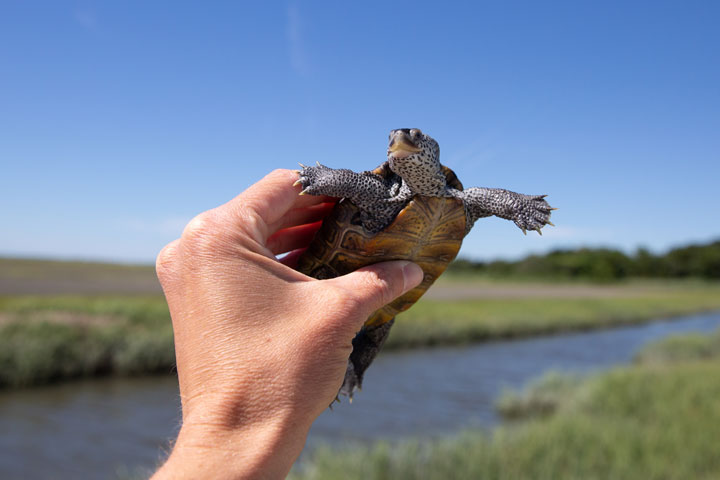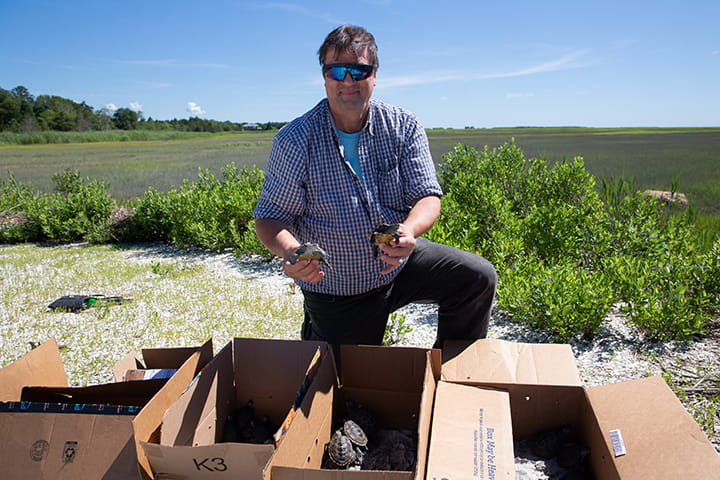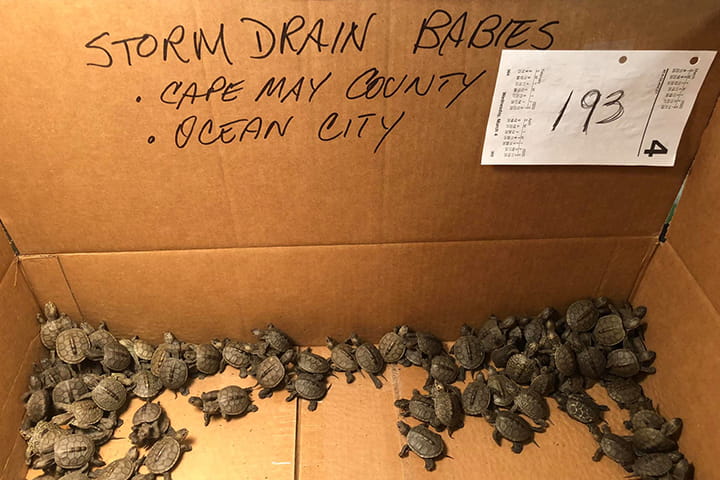A Record Rescue
By Susan Allen '09, '14

By Susan Allen '09, '14

E nrollment in the Diamondback terrapin “head start” program at Stockton University’s vivarium soared during the pandemic with the help of community members.
The conservation effort is not new, but this year’s record rescue effort made headlines internationally and caught the attention of Jimmy Fallon who mentioned the terrapins on the Tonight Show after a Facebook post introduced their rescue to the world.
In April, Stockton received more than 1,000 hatchlings known as spring emergers, meaning that they hid from the winter temperatures underground in their nests and dug out when the weather warmed.

"Eggs laid later in the year hatch out underground and spend the winter in the nest chamber surviving off their yolk sac," said John Rokita, assistant supervisor of Academic Lab Services.
When the warmth of spring awakens the tiny terrapins, their perilous journey begins.
After surviving a treacherous traffic crossing, a baby terrapin can meet other obstacles like curbs and storm drains.
Terrapins in Ocean City and Ventnor are lucky to have dedicated volunteers who patrol roadways, make rescues and deliver them to Stockton.
Although the water in storm drains will eventually flow into the bay, the unfiltered rainwater and runoff from roads and impervious surfaces is not a safe or healthy habitat. "A good percentage of the terrapins that do come from storm drains have eye infections. They haven't been in the cleanest water because everything runs into the storm drains," explained Rokita.
Terrapins that arrive with an infection are isolated from the general population in the vivarium until they are healthy.
Predators may not be in the drains, but they are lurking where they empty. "The water goes out into the big open bay, and they are little turtles. They are just like fish food out there," said Rokita.
When they arrive at the vivarium, they receive expert care from Rokita and his staff and continue to grow over the winter while their wild counterparts hibernate.
Twice daily feedings of hard food and chopped fish and summer temperatures all year long, allow the terrapins to grow strong much quicker.
Hatchlings spend about a year at Stockton under optimum growing conditions to give them a head start prior to being released back into the wild. A head-started terrapin is 2-3 times larger than a wild terrapin of the same age. Take a photo tour to see the Vivarium.
With the Vivarium reaching maximum capacity early in the year, a Stockton #WildlifeWednesday social media post outlined the steps to give a hatchling the best chance at survival. Shore communities began spreading the message, media outlets took interest and the post was shared more than 2,500 times.
Rokita fielded interview questions on the phone between feedings and changed the water in their tanks early to prepare for TV reporters who captured footage of the camera-shy terrapins that slid off their basking rocks at first glimpse of the lenses.
On June 24, terrapin rescuers from the community joined Rokita and Stockton staff to release last year’s head-started turtles, which has freed up space in the Vivarium for this season’s rescues to grow big over the winter.
In the coming weeks, more terrapins will arrive from a conservation partnership with The Wetlands Institute in Stone Harbor that extracts and incubates eggs from road-killed females.
If you find a hatchling emerging from its nest this summer, watch our Instagram Reel for how to give it the best chance at survival.
The Stockton Foundation is currently raising funds to keep the hungry hatchlings growing quickly. Terrapin expenses include the tanks they live in, frozen smelt and silversides as well as pelleted food, hoses and salt to make their brackish environment, light bulbs and fixtures to keep them warm and other miscellaneous supplies. Click on the link to help save the terrapins.

Learn more about Stockton's School of Natural Sciences and Mathematics.